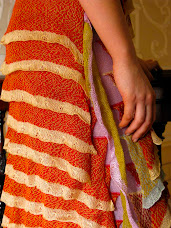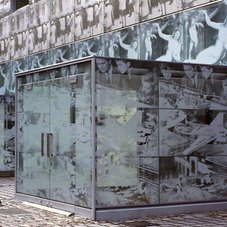 Designer, Gianni Lauren, formerly with the boutique, Burrow in SoHo (now relocating to Nolita), paints recycled t-shirts with dyes and uses safety pins as closures. Burrow represents designers working with recycled materials. Mary Jaeger is producing incredible shibori dyed t-shirts, and although the website hasn't been updated since 2005, it's worth looking at,unless you happen to be in Nolita, http://www.maryjaeger.com/sp05/index.html
Designer, Gianni Lauren, formerly with the boutique, Burrow in SoHo (now relocating to Nolita), paints recycled t-shirts with dyes and uses safety pins as closures. Burrow represents designers working with recycled materials. Mary Jaeger is producing incredible shibori dyed t-shirts, and although the website hasn't been updated since 2005, it's worth looking at,unless you happen to be in Nolita, http://www.maryjaeger.com/sp05/index.htmlFeeling guilty about using Durock, ecomodista is still researching the environmental impact of concrete, and because the weather is gloomy, will dye a few garments that need brilliant color. This is an excellent means of recycling clothing that happens to be last season’s color or simply the wrong color. Dyeing a darker color over a pale shade is definitely easiest. For many years, ecomodista didn’t care what color she bought, as long as it was silk, cotton, cashmere or wool, it could be dyed black, favored by those New Yorkers laboring under self imposed sumptuary laws, mandating black--black sweaters, black skirts, black trousers, black jeans, etc. I bought quart cans of Deka black dye at Pearl Paint.
German dyes are most effective, especially those designed for batik. Unfortunately Deka is no longer available in this country, so ecomodista is using vegetal dyes when possible or Leight & Bunt manufactured by Marabuwerke GmbH & Co founded in 1859 by Albert Martz in Stuttgart, Germany.
If you are wondering if dyes are toxic, see Paula Burch’s site, which has technical information regarding the various types of dyes. Queried whether Procion dyes are safe, Deka is also discussed:
http://www.pburch.net/dyeing/dyelog/B1063361308/C1307213733/E1925627151/index.html
OSHA, http://www.osha.gov/SLTC/textiles/index.html and the CDC have information regarding the safety of chemical dyes, and personally I use a respirator whenever using ANY material with particulates. Another site with useful safety information is: http://www.ci.tucson.az.us/arthazards/text1.html
You get the point. Generally, natural dyes have numerous advantages in terms of safety. An excellent source of black may be derived from black walnuts, in fact, the dye is so intense, wear disposable gloves when picking these in late autumn.
All Fiber Arts is an excellent resource, including instructions for natural dyes, including cochnineal derived from the insects, Dactylopius coccus, inhabiting prickly pear cacti and a recipe for indigo derived from Indigofera tinctoria and Indigo suffraticosa. Indigo for commercial use is synthesized. In temperate climates indigo is obtained from woad (Isatis tinctoria), indigenous to Europe, and dyer's knotweed (Polygonum tinctorum) from China, Japan and Korea. These plants have been considered inferiorsources of indigo dye because they contain less indigo than the tropical indigofera. Modern analysis shows that this assumption may be incorrect and a result of inefficient processing and poor understanding of the dye. Farming dye-bearing crops is enjoying a renaissance as people in western countries look further and further into a more organic and sustainable lifestyle.
See: http://www.allfiberarts.com/
German dyes are most effective, especially those designed for batik. Unfortunately Deka is no longer available in this country, so ecomodista is using vegetal dyes when possible or Leight & Bunt manufactured by Marabuwerke GmbH & Co founded in 1859 by Albert Martz in Stuttgart, Germany.
If you are wondering if dyes are toxic, see Paula Burch’s site, which has technical information regarding the various types of dyes. Queried whether Procion dyes are safe, Deka is also discussed:
http://www.pburch.net/dyeing/dyelog/B1063361308/C1307213733/E1925627151/index.html
OSHA, http://www.osha.gov/SLTC/textiles/index.html and the CDC have information regarding the safety of chemical dyes, and personally I use a respirator whenever using ANY material with particulates. Another site with useful safety information is: http://www.ci.tucson.az.us/arthazards/text1.html
You get the point. Generally, natural dyes have numerous advantages in terms of safety. An excellent source of black may be derived from black walnuts, in fact, the dye is so intense, wear disposable gloves when picking these in late autumn.
See: http://www.mannamcarpets.com/dyeBr.html for instructions using walnut bark to make brown dye and for other websites,  natural dyes
natural dyes
All Fiber Arts is an excellent resource, including instructions for natural dyes, including cochnineal derived from the insects, Dactylopius coccus, inhabiting prickly pear cacti and a recipe for indigo derived from Indigofera tinctoria and Indigo suffraticosa. Indigo for commercial use is synthesized. In temperate climates indigo is obtained from woad (Isatis tinctoria), indigenous to Europe, and dyer's knotweed (Polygonum tinctorum) from China, Japan and Korea. These plants have been considered inferiorsources of indigo dye because they contain less indigo than the tropical indigofera. Modern analysis shows that this assumption may be incorrect and a result of inefficient processing and poor understanding of the dye. Farming dye-bearing crops is enjoying a renaissance as people in western countries look further and further into a more organic and sustainable lifestyle.
See: http://www.allfiberarts.com/









